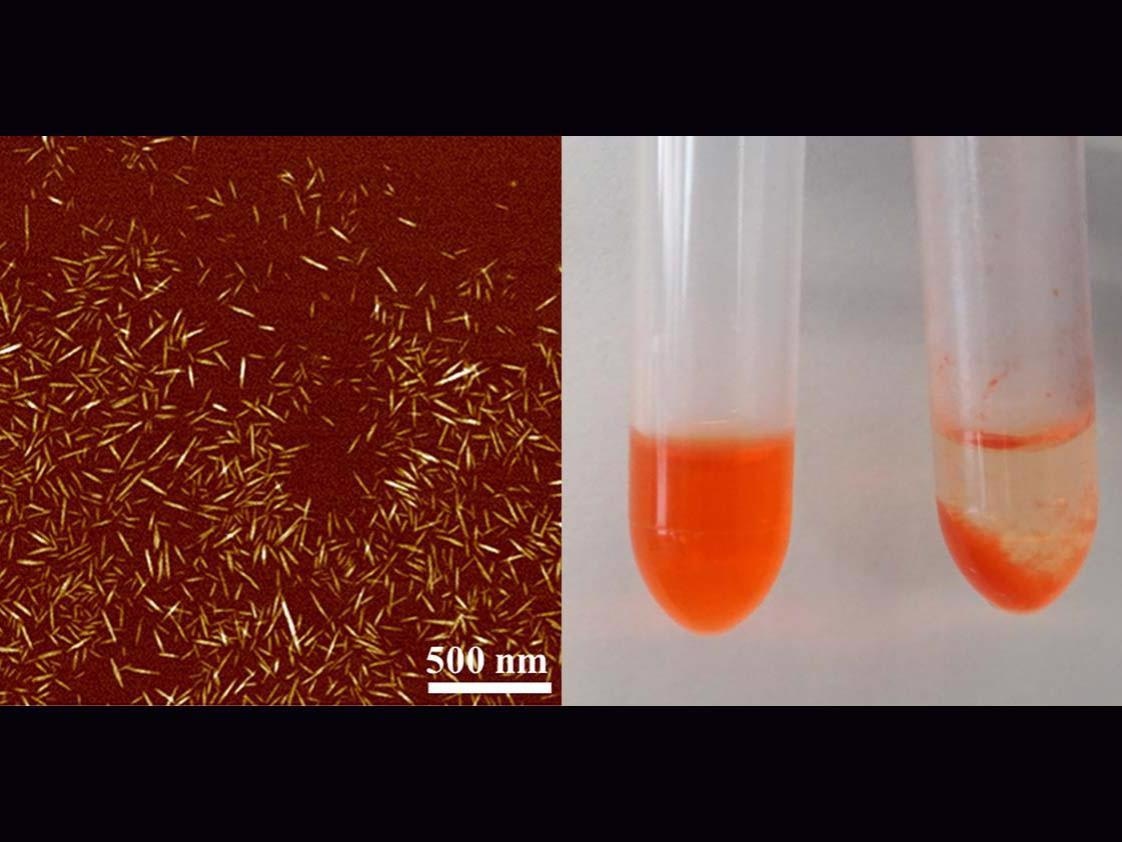Customary chemotherapies may effectively destroy cancer cells, but they also tend to be a great risk to healthy cells, thereby leading to secondary illness and reduced quality of life for patients.
 A multi-institute research team engineered specialized hairy cellulose nanocrystals, left, developed from the main component of plant cell walls and used in a variety of materials, including paper, to capture off-target chemotherapy drugs to prevent tissue damage, right. Both tubes contain human blood serum and a common chemotherapy drug. The right tube also contains the nanocrystals, which captured the drug, separating it from the blood serum. (Image Credit: Amir Sheikhi/Penn State University).
A multi-institute research team engineered specialized hairy cellulose nanocrystals, left, developed from the main component of plant cell walls and used in a variety of materials, including paper, to capture off-target chemotherapy drugs to prevent tissue damage, right. Both tubes contain human blood serum and a common chemotherapy drug. The right tube also contains the nanocrystals, which captured the drug, separating it from the blood serum. (Image Credit: Amir Sheikhi/Penn State University).
To avoid the formerly inevitable damage, scientists, led by Penn State University (PSU), have created a new group of nanomaterials designed to capture chemotherapy drugs before they impact healthy tissue.
To reduce the off-target effects of cancer drugs during and after localized chemotherapy, eliminating their systemic circulation is necessary. Available and proposed platforms to remove unwanted drugs — primarily the chemotherapy drug doxorubicin (DOX) — from blood are exceedingly ineffective, failing to remove enough of the drug to prevent damage.
Amir Sheikhi, Principal Investigator and Assistant Professor, Chemical Engineering and Biomedical Engineering at Penn State University
“We have developed a highly efficient approach that captures DOX at a capacity more than 3,200% higher than other platforms, such as DNA-based materials,” Sheikhi added.
The process is based on hairy cellulose nanocrystals — nanoparticles created from the key component of plant cell walls and designed to contain huge numbers of polymer chain “hairs” extending from each end. Details of the process can be seen online prior to the March issue of Materials Today Chemistry.
According to Sheikhi, these hairs boost the potential drug capture capacity of the nanocrystals considerably beyond that of standard nanoparticles and ion exchange resins.
“To the best of our knowledge, there is currently no nanoparticle-based super-capacity drug capture system,” Sheikhi said, observing that the creation of such a system could have a substantial effect on cancer treatment plans.
For some organs, like the liver, chemotherapy can be locally administered through catheters. If we could place a device based on the nanocrystals to capture the excess drugs exiting the liver’s inferior vena cava, a major blood vessel, clinicians could potentially administer higher doses of chemotherapy to kill the cancer more quickly without worry about damaging healthy cells. Once the treatment is finished, the device could be removed.
Amir Sheikhi, Principal Investigator and Assistant Professor, Chemical Engineering and Biomedical Engineering at Penn State University
To create the hairy cellulose nanocrystals that can capture chemotherapy drugs, the scientists chemically treated cellulose fibers present in softwood pulp and conveyed a negative charge on the hairs, making them stable against the blood’s ionic composition.
According to Sheikhi, this amends a fault of conventional nanoparticles, whose charge can be made inert or reduced when exposed to blood, restricting the number of positively charged drug molecules it can bind with to inconsequential numbers.
The binding efficacy of the nanocrystals was tested in human serum, the protein-rich portion of blood that does not contain platelets or red or white blood cells. For every gram of hairy cellulose nanocrystals, over 6,000 milligrams of DOX were effectively eliminated from the serum.
“The hairy nanocrystals allowed us to push the limit by at least two-to-three orders of magnitude compared to some other available platforms,” Sheikhi said.
The scientists also discovered that the nanocrystals had no damaging effect on red blood cells in whole blood or on cell growth in human umbilical vein endothelial cells.
We found that the hairy cellulose nanocrystals bind to positively charged drugs in human serum and capture DOX immediately, and they do so without imposing any cytotoxicity or hemolytic effects. We envision that this effective, non-toxic nanoparticle could be a building block for the next generation of devices to capture excess drugs and remove unwanted molecules from the body, such as psychedelics and toxins.
Amir Sheikhi, Principal Investigator and Assistant Professor, Chemical Engineering and Biomedical Engineering at Penn State University
According to Sheikhi, the application of hairy cellulose nanocrystals has broad implications beyond the human body. His team recently designed nanocrystals that can selectively bind to neodymium, a rare earth element, to extract useful material from electronic waste.
“We’re excited to introduce a new material with such a high capacity to separate a variety of elements, which will hopefully open new opportunities for a broad range of applications,” Sheikhi said.
Sheikhi began this work as a postdoctoral scholar at the University of California, Los Angeles, in the laboratory of Ali Khademhosseini, currently the chief executive officer of the Terasaki Institute for Biomedical Innovation.
Other contributors from PSU include Joy Muthami and Patricia Wamea, both recent Master of Science in chemical engineering graduates; and Mica Pitcher, a doctoral student in chemistry.
UCLA contributors include Peter Antovski, Sarah A.E. Young, Robert Denis Murphy, Andrew Schmidt, Samuel Clark and, for a part of the research, Reihaneh Haghniaz. Haghniaz is currently affiliated with the Terasaki Institute for Biomedical Innovation.
This research was funded by the National Institutes of Health, the Canadian Institutes of Health Research, and PSU.
Journal Reference:
Young, S. A. E., et al. (2021) Engineering hairy cellulose nanocrystals for chemotherapy drug capture. Materials Today Chemistry. doi.org/10.1016/j.mtchem.2021.100711.